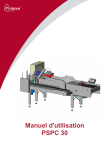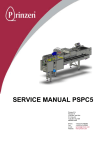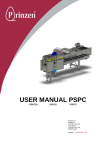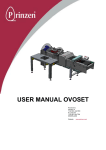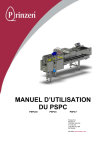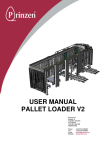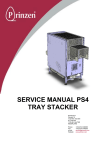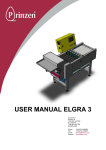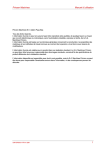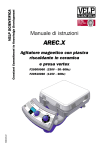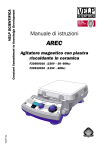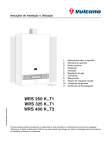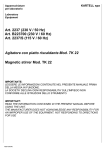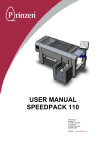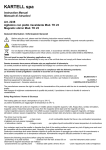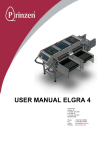Download Users manual PSPC 30
Transcript
Users manual PSPC 30 Prinzen Machines Users manual Prinzen Machines BV Aalten – The Netherlands All rights reserved. Information provided by Prinzen Machines BV may not, in part or in whole, be copied, archived and/or published in any way, without written permission of Prinzen Machines BV. All information provided regarding construction, materials and production methods is based on general information available at the time of printing. Please note that specifications found herein are subject to change at any time. The information provided is valid for the standard design of the product. Prinzen Machines BV accept no responsibility for any damage caused by parts of the machine which differ from the standard design of the product. Prinzen Machines BV accept no responsibility for errors or incorrect information found in this publication or indeed the consequences of these errors. E121 1 Prinzen Machines Users manual INDEX INDEX.....................................................................................................................................................2 PREFACE ..............................................................................................................................................3 1 INTRODUCTION ................................................................................................................................. 4 1.1 Aim and function of the PSPC. ...................................................................................................... 4 1.2 Standard version. ............................................................................................................................ 4 1.3 Options. ............................................................................................................................................ 4 1.4 External machine components. ....................................................................................................4 2 SAFETY NOTES ................................................................................................................................. 5 2.1 Permitted use................................................................................................................................... 5 2.2 General safety notes. ...................................................................................................................... 5 2.3 Specific safety notes for the PSPC packing machine ................................................................. 7 2.4 Emergency stop............................................................................................................................. 8 2.5 Cleaning. .........................................................................................................................................8 3 OPERATION ..................................................................................................................................... 9 3.1 Working Operation. ....................................................................................................................... 9 3.2 Operation...................................................................................................................................... 10 3.2.1 Starting the machine ................................................................................................................ 11 3.2.2. Stopping the machine ............................................................................................................. 11 3.2.3 Working with the machine........................................................................................................12 4 INSTALLATION ............................................................................................................................... 13 4.1 Installation checklist ....................................................................................................................13 5 MAINTENANCE NOTES ................................................................................................................ 13 5.1 General. ........................................................................................................................................ 13 5.2 Daily maintenance. ...................................................................................................................... 14 5.3 Weekly maintenance. .................................................................................................................. 14 5.4 Monthly maintenance.................................................................................................................. 14 5.5 Half-yearly maintenance. ............................................................................................................ 14 5.6 Maintenance notes. ..................................................................................................................... 17 5.7 Environment................................................................................................................................. 17 5.8 Environment consequences. ......................................................................................................17 6 ADJUSTMENTS.............................................................................................................................. 17 6.1 General. ........................................................................................................................................ 17 6.2 Electrical: Main control box. .......................................................................................................18 7 SPECIFICATIONS .......................................................................................................................... 19 7.1 Machine specifications. .............................................................................................................. 19 7.2 Electrical specifications. ............................................................................................................ 19 7.3 Air supply specifications. ........................................................................................................... 19 7.4 Physical requirements. ............................................................................................................... 19 7.5 Directives and standards used: ..................................................................................................19 EG EXPLANATION OF AGREEMENT ...............................................................................................22 E121 2 Prinzen Machines Users manual PREFACE About this document. This document intended as a reference book, for users, to work with the machine which is represented on the cover of this document. Keep this manual in a permanent place, close to the machine. If the manual is lost or damaged, order a new copy as soon as possible. The manual gives information about safety, technical specifications, operating instructions and maintenance. Before operating the machine, you should read this manual and be aware of all information printed therein. The Prinzen PSPC has been carefully developed and has CE approval. Modifications to this machine or it’s component parts will negate this approval and therefore are not permitted. The machine has been thoroughly inspected before shipping. Each machine has a unique registration number which is printed on the machine tag. When contacting a service engineer or dealer, Please have this number available. Prinzen Machines BV is not responsible for any damage or injury caused by neglecting to follow the instructions provided in this manual. Directions for use. All users of the machine or anyone near the machine, should be aware of the contents of this manual. Management should instruct all personnel with reference to machine operation & safety procedures using this manual. Never change the sequence of procedures. This manual must be accessible to all personnel using or in close proximity to the machine at all times. E121 3 Prinzen Machines Users manual 1 INTRODUCTION 1.1 Aim and function of the PSPC. The PSPC packer has been developed to pack a random supply of eggs from the egg infeed belt into 30 cell packaging. This may be either plastic or cardboard trays with a capacity of 30 eggs in a pattern of 5 x 6. The eggs are packed points down into the packaging. 1.2 Standard version. The standard version of the PSPC is constructed with the following parts: • • Mainframe with peak absorber, roller transport, cup conveyor and control unit. Output conveyor incl. denester for 30 cell trays 1.3 Options. The following options are available for the PSPC: • Infeed extension • tray stacker Specifications regarding the above options are available at your local Prinzen dealer. 1.4 External machine components. The following items are not considered to be part of the machine. • • • • • E121 Electrical supply. Connection to the electricity supply. Compressed air supply. (if applicable). Connection to the air supply. (if applicable). Stamping tool 4 Prinzen Machines Users manual 2 SAFETY NOTES The following safety notes concern the standard version of the PSPC. The safety notes concerning the options and extensions etc. are represented in their respective manuals. 2.1 Permitted use. The PSPC has been developed for packing eggs into specific packaging. Any other use of the machine is not permitted. 2.2 General safety notes. 2.2.1 Caution! Read the user manual of this packing machine before using, & be fully aware of the function of all switches. 2.2.2 Caution! To prevent accidents or personal injury during maintenance works; 1.Switch off the main switch and push the emergency stop button 2.Isolate the external mains supply to the machine. 3.Install a sign “out of use” in a clearly visible position on the machine. 2.2.3 Caution! To prevent accidents or personal injury during trolley movements; • Make sure no one is near whilst moving trolleys. • Warn bystanders to keep clear. 2.2.4. Caution! To prevent accidents or personal injury. The emergency stop circuit must be tested every week. 2.2.5 Caution! To prevent accidents or personal injury. Never move or disable the proximity switches and photocells & other safety devices 2.2.6 Caution! To prevent accidents or personal injury. Operators should ensure that close-fitting apparel is worn & a hair-net used to prevent hair and clothing being caught in the machine. 2.2.7 Caution! Danger for injury by electrical voltage. Injury & danger of death may occur when the electrical voltage does not conform to the type plate of the machine, or when the cable diameter, fuses and earth connection are not according to local regulations that may apply or when not installed by a qualified electrician. E121 5 Prinzen Machines Users manual 2.2.8 Caution! To prevent accidents or personal injury. Make sure that there is sufficient light around the machine. . 2.2.9 Caution! To prevent accidents or personal injury. Make sure that maintenance and service work is carried out by skilled personel. 2.2.10 Caution! To prevent accidents or personal injury. The machine is NOT operated by ; • Persons younger than 16 years. (Age laws may differ from country to country) • Untrained personnel. • Incompetent persons who would not understand the possible dangers of the machine. 2.2.11 Caution! To prevent accidents or personal injury. Operators must be aware of all information contained within the manual & should adhere to all instructions & safety information given when operating the machine. All safety notes & operating instructions should be given to any new user of the machine. 2.2.12 Caution! To prevent accidents or personal injury. Keep children and incompetent persons away from the machine. 2.2.13 Caution! To prevent accidents or personal injury, due to falling or slipping. Make sure that the machine and the area around the machine is cleaned regularly, is free of obstacles and that production materials do not cause an obstruction for working or servicing the machine. 2.2.14 Caution! To prevent accidents or personal injury. Make sure that all warning signs are legible and are not damaged or removed. Keep the pictograms clean and, if unclear or illegible, replace them. 2.2.15 Caution! Only use genuine “Prinzen Machines” or CE-certified parts for replacement. 2.2.16 Caution! To prevent accidents or personal injury. Use the machine only for the purpose as described in section 1 of this manual. 2.2.17 Caution! Danger of injury by fire or short-circuit. With using an extension cable, make sure that the cable diameter in relation to the length of cable is correct. If unsure, ask your local installer. Make sure that the cable is completely unrolled. 2.2.18 The user determines the limits of “working safely” with the machine. Do not take any risks. Be especially cautious at time of machine failure, always stop the machine first ,push the emergency stop button, switch off the main switch and wait until the machine has come to a complete stop before correcting the failure. E121 6 Prinzen Machines Users manual 2.3 Specific safety notes for the PSPC packing machine 2.3.1 Inputconveyor Caution! Danger of serious injury by jamming between; The input conveyor and the gates The input conveyor and the moving gate fingers The input conveyor and roller conveyor The drive tooth wheels off the input conveyor Keep clear of this area when machine is running . 2.3.2 Roller conveyor Caution! Danger of serious injury by jamming between; The roller conveyor and cup conveyor The roller conveyor and drive surface The roller conveyor and turning disc shaft Keep clear of this area when machine is running . 2.3.3 Cupconveyor Caution! Danger of serious injury by jamming between; The cupconveyor and the guideshafts. Keep clear of this area when machine is running . 2.3.4 Stampingunit Caution! Danger of serious injury by jamming between; The motor drive and driveshaft The stamping tool and machine frame The stamping tool and cup conveyor Keep clear of this area when machine is running . 2.3.5 Drivesystem, cupconveyor and rollerconveyor. Caution! Danger of serious injury by jamming between; The drive system with tooth wheels ,sprockets and chain for driving the cup conveyor and roller conveyor. Keep clear of this area when machine is running . After maintenance ensure all guards and protective covers are correctly fitted. 2.3.6 Transferarm Caution! Danger of serious injury by jamming between; The transfer arm and machine frame The transfer arm and cup conveyor The transfer arm and output conveyor Keep clear of this area when machine is running 2.3.7 Denester Caution! Danger of serious injury by jamming between; The denester frame and machine frame The drive off the denester Tooth wheels of the denester drive Keep clear of this area when machine is running. After maintenance ensure all guards and protective covers are correctly fitted. E121 7 Prinzen Machines Users manual 2.3.8 Outputconveyor Caution! Danger of serious injury by jamming between; The driverdisc and frame Keep clear of this area when machine is running. 2.3.9 Caution! Before starting maintenance: 1 Read user manual first. 2 Switch main switch to off position 3 Push an Emergency stop 4 Place an instruction “Maintenance –out of use” on the main panel. The warning signs above have been placed on your machine. Learn and understand the meaning of these signs. 2.4 Emergency stop To stop the machine in case of emergency, the machine has an emergency stop button on the main control box. The emergency stop button can be recognized by its red colour. When the emergency stop button is pressed, the machine stops immediately. The button stays mechanically locked so that the machine can not restart until it is considered safe to do so. When the problem is resolved, the emergency stop button may be released by turning it to the right. The start-up procedure is described in the operating instructions. The emergency stop button may also be used if the machine suddenly develops a fault. Recommendations: • • • New operators should have some practical experience using the emergency stop & the startup procedure. The emergency stop should be tested regularly. Do not de-activate the emergency stop button when it is not certain why and by whom it was activated. 2.5 Cleaning. The PSPC may be cleaned with water. Make sure that the main switch is in the off position before cleaning. (see section 5: maintenance) E121 8 Prinzen Machines Users manual 3 OPERATION 3.1 Working Operation. Main frame: The eggs roll from the egg collection belts onto the input conveyor(01) where the eggs may be graded. On this belt, oversized, misshapen, cracked or dirty eggs should be manually rejected. The eggs run into the gates where they are detected by photocells(06). When all gates have detected eggs, the rollers will move one step forwards. The rollers are so shaped as to orient each egg with the pointed end to each side of the roller when moving forward. As the eggs reach the cups(03), each egg is gently turned and allowed to enter the cup points down. If an egg blocks the cup detection photocell(07) (mounted in between the rollers & the cup conveyor) the machine will stop. An alarm status will appear on the counter system LCD . The cup conveyor is in synchronization with the roller conveyor and will move forwards until the “transfer photocell”(08) detects the first line of eggs. The eggs are lifted by vacuum with the transfer lever and are taken to the output conveyor where a tray is waiting. A positive airflow is given to the vacuum lifter and the eggs are released. As the transfer photocell is cleared, the cups move forwards once more. Output Conveyor: The automatic denester(04) will set a tray onto the output conveyor every time the photocell “start denester”(09) is uncovered. The tray moves forwards until it reaches the stopper(10). When the photocell “tray present” detects a tray, the transfer arm will be enabled & will operate when filled cups have arrived at the correct position. When the transfer arm has placed the eggs into the waiting tray, the stopper will be activated, so that the full tray may move forward whilst the empty trays are blocked. When the photocell “tray present”(10) is not blocked, the stopper will be released & an empty tray may once again move up to the stopper. . E121 9 Prinzen Machines Users manual 3.2 Operation. All operators of the machine, must be familiar with the safety procedures from section 2 of this manual. This section is meant for operators as described in section 2.4. Operating activities which are not found in this section may only be carried out by service personnel. Operating instructions for optional equipment are explained in the relevant sections. The control panel contains the following:• • • • Start and stop pushbuttons Selector switch - “clear” Emergency stop button Operators display The selector switch "denester" found near the denester has 3 positions : "inch" the denester is working manual. "off" denester off, the denester is not working. "on" denester on, the denester is working automatic. DENESTER INCH OFF ON The selector switch "stamping" has 2 positions : "0" stamping off, the stamping is not working. "1" stamping on, the stamping is working. STAMPING 0 1 E121 10 Prinzen Machines 3.2.1 Starting the machine Before starting the machine, Ensure that no one is working on the machine and that it is safe to start. Users manual Switch main switch on (1-On) Press start Light on start button off No Check emergency stop push buttons Yes Press start Self test Transfer arm to initial position cups to initial position stacker* to initial position automatically Self test OK No Transfer arm Cups Stacker* Move to initial position automatically Yes Press start * stacker if applicable Machine running 3.2.2. Stopping the machine Machine running Selector switch clear overrules egg detection photocells. The rollers en cups make a continuous step movement. This function is used to clear the last eggs from the machine. Selector switch clear To position 1 Last eggs packed No Yes Press stop All movements stopped No Yes Switch main switch off (0-Off) Machine off E121 11 Prinzen Machines Users manual 3.2.3 Working with the machine a. denester Before starting the machine, the denester has to be filled with trays. 1. Turn the selector switch on the denester control box to the left (manual position). 2. Place a stack of trays into the denester bunker (tray handgrips to the side). 3. Turn the denester to automatic by turning the switch to the right. When the trays in the stack are packed tightly into each other you may have to knock the stack to loosen the trays before filling the bunker. Note. Moving the selector switch to the “inch” position the denester can be operated in steps. b. starting and stopping By pushing the white start button, the infeed belt & egg collecting belts will run. The machine will then work as described at 3.1. When the black stop button is pushed, the machine will stop, after all cycle stop positions are achieved. c. possible faults. If a fault should occur on the machine, the display will show the corresponding alarm message: Egg not lifted by suction box One or more eggs have stayed behind in cups after transfer movement. Stopped at transfer Egg not positioned in cup right at the transfer Denester fault – no tray out Denester has not denested correctly Conveyor full The output conveyor is full of trays No tray present Emergency stop – unlock button and press start There is no tray at transfer position. An emergency stop button has been pushed. See par. 2.4 Unlock button and press start Denester off Denester switch is not in “auto" position Transfer fault The movement of the transfer arm has not finished in a certain time- See service manual Stacker fault- press start for retry Check cup detection/flaps – then press start Stacker (if applicable) has not finished initial movement correctly-See service manual Mill is not adjusted correctly, is defective or dirty. After the cause off the interruption has been rectified press start to continue. d. Other functions Egg transport. Two pressure switches are mounted on both sides of the input conveyor. When the machine is running (input conveyor running), the egg collecting belts will automatically start(if connection to egg collection system is made).As soon as one of the pressure switches are being pushed by eggs for a certain time, the egg collecting belts will come to a stop. After both pressure switches are clear for a E121 12 Prinzen Machines Users manual certain time, the egg collecting belts will start automatically again. Both times are adjustable (see service manual). 4 INSTALLATION 4.1 Installation checklist 1) Before removal from shipping pallet, check for signs of shipping damage. Report at once to Prinzen Machines if found. 2) Remove from pallet. 3) Using the lifter trolley to position main frame to egg collection belt/s. 4) Set the height of the infeed table to be approx. 5mm below the discharge point of the belt transfer plate. At this stage it is best to run the collection belt with a few eggs to ensure that the transfer is satisfactory. 5) Level the machine. Re-check the transfer dynamically before moving on. 6) Connect the cables to the main panel. Connect every wire according to the electric schematic. 7) Place the output conveyor in position. 8) Remove transfer arm support (wood) 9) Arrange for the electric supply to be connected.* 10) Switch on the electrical supply. 11) Start the machine according to par 3.2.1. 12) Check for the correct direction of the input belt. If the direction is incorrect: isolate the electric supply at the external source. Exchange the wires going into terminals L1 & L2. with each other. 13) Repeat steps 9 through 10. 14) Remove cable tie from motor protection switch Q3 and push black button. 15) Re-route the conveyor cables and fix with cable ties. 16) Arrange for the egg collection belt control cable is connected to terminals according to electrical schematic. 17) Check the entire machine for loose set screws and fixing bolts etc. * note; the electrical supply connection must be made by an approved electrician, according to local regulations. 5 MAINTENANCE NOTES 5.1 General. To extend the useful life of the machine it is necessary to maintain the machine correctly. Neglecting the correct maintenance procedures may lead to damage or accidents. Prinzen Machines BV will not be held responsible for such accidents. Maintenance may only be carried out by trained service personnel. Such personnel should be aware of the following:- E121 13 Prinzen Machines Users manual • Consult the manual before work commences . • Turn the main switch off and push in the emergency button. • If working under the machine or out of view, always lock the main switch with a padlock. When the maintenance work is complete, ensure the following :• • • • All fasteners are secure. All tools & cleaning cloths etc. are removed from the machine. All guarding is securely in place. The machine is tested before handing over to operation personnel. By following the above points, dangerous situations may be prevented. In principle, the machine may be cleaned with water. But one should take note that electrical & pneumatic components are not subjected to prolonged exposure to liquids. • Never use high pressure water on the main control box, plastic (breakable) parts, bearings or electrical components. Prinzen Machines BV will not be responsible for damage caused by careless cleaning of the machine. • Always turn the main switch to the off position when cleaning any part of the machine. • After cleaning the machine with water, all bearings and chains should be lightly oiled. 5.2 Daily maintenance. • After turning off the machine, all dirt, grease and feathers should be removed from the machine. • Clean the drip trays with water. • Clean the input conveyor with a moist cloth. 5.3 Weekly maintenance. • Clean the shafts of the cups and, when necessary, Apply Teflon spray. Use food grade specified lubricants. • Check the emergency stop procedure. Push the emergency button. The white light on the reset switch should light. 5.4 Monthly maintenance. • Oil all chains. There are five chains on the machine. These are: 2 cup conveyor chains(no. 1). 2 roller conveyor chains(no. 2). 1 main drive chain (behind cover)(no. 3). If sufficient oil is present, do not re-apply further oil. The rollers & roller drive section should remain free of oil or grease to prevent product contamination. fig. 5.4 • Clean the suction unit by loosening the four bolts and remove the unit from the machine. Then clean the unit with air pistol. Always wear eye protection when using compressed air.(no. 5) • Check legibility of all warning signs and clean or replace as necessary. • Oil the denester guides(no. 4) and guides(fig. 5.4) • Clean the fans of all motors using air pistol. • Check the filter of the vacuum pump and replace if necessary (no.6) • Spray rollers with silicone spray. 5.5 Half-yearly maintenance. • Check the tension of the output conveyor belts • Check the tension of the infeed belt 14 E121 fig. 5.5 Prinzen Machines Users manual • Check the main drive chain for wear. If the yellow part on the tensioner (fig 5.5) gets visible, the chain should be replaced. • Check all bearings for play • Check entire machine for loose parts, bolts, nuts etc. E121 15 E121 6 Vacuum filter 4 Oil 3 Oil 5 1 Oil 2 Oil Prinzen Machines Users manual 16 Prinzen Machines Users manual 5.6 Maintenance notes. • All motors are provided with life time lubrication, and require no maintenance. • All bearings are “sealed for life” & require no lubrication. Repair and/or change of parts: • During warranty period, repairs may only be executed by Prinzen Machines BV or service personal provided by Prinzen Machines BV. • All parts replaced must be of at least the same specification as the original parts. • All parts should be ordered from Prinzen Machines BV or your local Prinzen dealer. 5.7 Environment. Residues of oil and other lubrication, oilcloths and cleaning fluids must be discharged as chemical waste. 5.8 Environment consequences. The life expectancy of the machine depends on the amount of maintenance given, running hours and other environmental conditions. Dismantling & disposal of the machine must be carried out by a suitable disposal company which has the required licenses and/or permits for the state or country concerned. Dismantled materials should be sorted for disposal according to local rules and regulations that may apply. Separate all materials like oil and lubrication fluids and discharge them as chemical waste. 6 ADJUSTMENTS 6.1 General. Neglecting to follow the correct adjustment directions, may lead to machine damage or personal injury. Prinzen Machines BV is not responsible for any such damage or injury incurred in this way. Maintenance may only be carried out by trained service personnel. Such personnel should be aware of the following: • • • Consult the manual before work commences . Turn the main switch off and push in the emergency button. If working under the machine or out of view, always lock the main switch with a padlock. When the maintenance work is complete, ensure the following; • • • • All fasteners are secure. All tools & cleaning cloths etc. are removed from the machine. All guarding is securely in place before starting the machine. Test the machine before handing over to operation personnel. By following these guidelines, dangerous situations and/or machine damage may be prevented. Repair and/or change of parts: • During warranty period, repairs may only be executed by Prinzen Machines BV or service personal provided by Prinzen Machines BV. • All parts replaced must be of at least the same specification as the original parts • All parts should be ordered from Prinzen Machines BV or your local Prinzen dealer. E121 17 Prinzen Machines Users manual 6.2 Electrical: Main control box. Isolate the external supply before working inside the control panel! • Warning : After switching off the main switch, the panel will remain “Live” for approx. one minute. The frequency controller may hold a high voltage charge during this time. Therefore, do not touch any part within the panel whilst the frequency control display is lit. • Several parts maintain voltage even if the main switch is turned off. • Work inside the control box may only be undertaken by skilled service personnel. Contrary to the above, the following actions may be executed without switching off the voltage: • Resetting of motor safety switches (F1-F3). Never operate the machine with electrical safety devices disabled or guarding removed. The construction of the main control box may vary and is dependant on optional equipment fitted (stacker, stamping device etc.). For the exact version refer to the appendix of the electrical diagrams. The figure below shows a general view of the control box. Safety devices inside the controlpanel; • F10 Circuit breaker control circuit* • F4 Circuit breaker inverters* • F1 Motor protection switch Vacuum pump • F2 Motor protection switch input conveyor • F3 Motor protection switch output conveyor • F18 fuse inputs (sensors, etc..), PLC • F19 fuse outputs (valves, clutch, etc..) 2Ampere/slow 6,3Ampere/slow * Machines running on a single phase system (CSA panel) have fuses on this position. E121 18 Prinzen Machines Users manual 7 SPECIFICATIONS 7.1 Machine specifications. Capacity: Size: Weight: Max 24.000 eggs per hour (continuously filled gates). Dependant on the machine type layout. ±650 kg (dependant on options fitted). 7.2 Electrical specifications. Voltage: Supply : Frequency: Power: Max current: Pre fuse: Note: Control voltage: 400V +10% -6% (standard, different voltages are possible on request) 3 phase, Earth & Neutral (standard, single phase is possible on request) 50Hz (standard, 60Hz is possible on request) 1,5 kW 6 Amp 16 Amp Type: slow In case of earth leakage protection, a leakage current of minimum 200 mA should be used. (specified for use with an inverter). 24VDC 7.3 Air supply specifications. For the standard version, compressed air is not required. If compressed air is required for options fitted, it should have the following : Pressure: Capacity: 6-10 bar regulated. (8 bar recommended) 11 liters/minute minimum. The air should be clean, dry and oil-free. Poor quality air will adversely affect certain components. 7.4 Physical requirements. Ambient working temperature: +10 to +30° Celsius During transport: 0° to 45° Celsius The machine is not suitable for outdoor use. The machine is not suitable for use in surroundings containing items having a high flash point or of an explosive nature. 7.5 Directives and standards used: The machine is provided with a CE-standard. This means that the machine comes up to European directives and standards concerning safety and health issues. The standards and directives are explained below. E121 19 Prinzen Machines Users manual Spare part list 1 2 3 4 5 6 7 8 9 10 11 12 13 Description Cup Suction cup fuse 2A slow 5x20mm fuse 2A slow 6x35mm fuse 6,3A slow 5x20mm fuse 6,3A slow 6x35mm Fuse 6A slow 10x38mm Fuse 2A slow 10x38mm Vacuum filter Photocell transmitter Photocell receiver Photocell Proximity switch Lamp bulb Oil 14 Silicon spray 15 16 17 18 bearing bearing bearing Vacuum tube E121 Type Single phase system(CSA) only Single phase system(CSA) only Single phase system(CSA) only Single phase system(CSA) only ET5505 1384 ET5505PPAP 1384 PA18CSD04PASA E2E2 X5MB1 5MTR BA9S 30V-2W (Klüber) Food grade oil type 4 UH1-1500 spray (Shell) Cassida Chain Oil 1000 (Interflon) Fin Food Lube (Klüber) Unisilkon food grade (Shell) Silicone Fluid ASPFL 204 6204 2Z 626 2Z PU 61021(25mm) Article code 220 070 001 350 010 001 800 040 104 800 040 150 800 040 107 800 040 151 800 040 153 800 040 152 780 030 030 800 010 038 800 010 037 800 010 019 800 010 020 800 030 451 105 010 007 …… …… 105 010 025 …… 700 050 014 700 050 023 700 050 009 500 011 016 20 Prinzen Machines E121 Users manual 21 Prinzen Machines Users manual EG EXPLANATION OF AGREEMENT Concerning the machine standards: Prinzen Machines B.V. Tweede Broekdijk 7 7122LB Aalten, Nederlands Phone: +31 (0)543 476251 Fax: +31 (0)543 476205 Declares on their responsibility: 1- We are the manufacturer of the egg packing machine: Brand: Type: Serial number: Prinzen PSPC On which this agreement relates: 2- The machine is developed in agreement with the demands of the machine standard 98/37/EEG (most recent). 3- The machine meets the requirements of the demands of the following EG-standards: The Low voltage standard 73/23/EEG.(most recent) The EMC-standards 89/336/EEG. (most recent) 4- The machine is developed and constructed according the European Standard: EN 60204-1:1993 Electrical equipment is of industrial machines. Signed in Date: Aalten Signed by: L. Prinzen E121 22

























